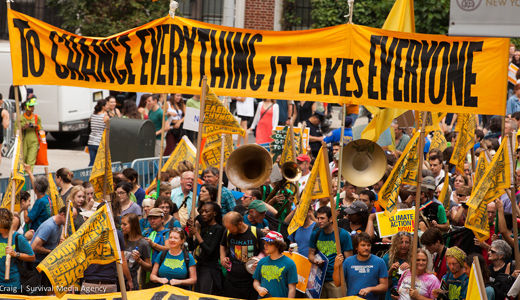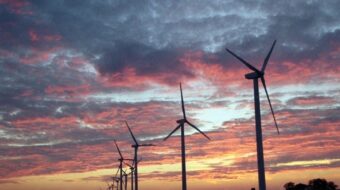
From the Chicago climate train full of activists, to the People’s Climate March itself, every person there seemed to feel passionately about a particular environmental issue. But all of them fully realized the scope of climate change as an overarching threat, and carried a message of resistance from Points A to B. The People’s World joined the crowd of 400,000 to find out how people will get to Point C – making definitive change in the fight to protect the environment.
The journey from the Windy City’s Union Station to Penn Station in Manhattan was an organized action in and of itself. People involved in the struggle took questions, shared stories, and held workshops. Among those who spoke was James Blakely, an activist from Boise, Idaho involved in LGBT organizing as well as climate organizing. He noted that he did not immediately feel included in the environmental struggle until he began to see it as one fight that involves everyone. “Several years ago,” he said, “I got involved in the fight to stop the Keystone XL pipeline. I initially felt a disconnect from it, until I got the opportunity to go see the tarsands [processing site] in Fort McMurray, Alberta.”
Blakely attended the Healing Walk there Jul. 27-29. The event was led by the First Nations people who are directly affected by tarsands operations, and it involved traversing local areas impacted by such activity – partly in protest, but also to call for healing of the land that has been ravaged by oil production. “I realized that Keystone XL is like an octopus that has tentacles in many places,” said Blakely. People from all walks of life “gathered at this event for workshops and ceremonies. There was a great feeling of diversity, openness, and respect. Then we did a walk through the tarsands; we saw some of the giant processing equipment they use. We heard propane cannons in the distance. Giant scarecrows were set up to scare away wildlife. This used to be an important forest and traditional hunting ground for First Nations tribes. But no more. Now everything is poisoned. I saw this and I realized that this is a fight that involves everyone.”
“This [climate march] is a big movement,” said Valerie Love, an organizer from Berkeley, Calif. who works with the Center for Biological Diversity, and who, at the time, was optimistically predicting a turnout of 250,000 for the march – almost 50 percent lower than the impressive actual turnout. “We are telling leaders that we need more than talk; we need bold action to make a safe, healthy, and livable future for our children and grandchildren.”
And the marchers took part in just that: bold action. People affected by natural disasters were there – signs reading “Remember Sandy?” and “Remember Katrina?” were thrusted upward in defiance. Another asked, “Mountaintops, glaciers, bayous – where have they all gone?” The march piqued the interest of several non-marchers, who seemed to slowly gravitate toward the throng from the sidelines. A sign held by 350 Seattle quoted President Obama: “We don’t have time for a meeting of the Flat Earth Society.” Perhaps the most poignant sign was one that simply read, “I’m marching for giving a sh*t.”
Some people were present for very simple, though no less compelling, reasons. “I’m here today because of the destruction of our planet,” said Nigel Sandering, a member of the World Wildlife Fund. “This march is great; it’ll draw a lot of attention. What’s disheartening, though, is that we’re not actually marching to anything. They’re not giving us the right to go to the UN,” he said, in reference to a last-minute failure for Climate March organizers to secure route approval for marching to the UN building. “I wish we could circumvent the current route. It would be a lot bolder and more confrontational if we could. But I’ll be surprised if things don’t get confrontational at some point, anyway.
“An event like this builds support, and even though the deck is stacked against us in terms of where the power lies, it’s gonna help if people go back home from this and do something within their local communities.” He admitted, “We’ve fallen into a trap where there’s limited control in the hands of the people, but events like this do have an effect. Systems can evolve, and we can help shift the balance of power. So things can change.”
Meanwhile, the march had no shortage of star power. Leonardo DiCaprio, Mark Ruffalo, Edward Norton, Joseph Gordon-Levitt, Kevin Bacon, Kiefer Sutherland, Evangelline Lily, and Susan Sarandon were among the actors present. Notable politicians participating included New York mayor Bill de Blasio, Al Gore, UN secretary general Ban Ki-moon, and 350.org’s Bill McKibben.
Also present was Sen. Bernie Sanders, I-Vt. In a brief statement to the People’s World, he remarked, “I’m here for the same reason as the other several thousand people here – because climate change is real, and it’s caused by human activity. And we need to work together to transform our energy system.”
The impact felt from the march reverberated through communities for days afterward, including on the return train to Chicago. After such an immense fight for the preservation of the earth, it was tragically ironic, then, that on this trip back, the train passed a number of enormous piles of petcoke. These piles are near a refinery, owned by the capitalist Koch Brothers and located on the southeast side of the city of Chicago, and are quite literally making people sick. For travelers, many of whom were in the march, seeing this image suddenly made the whole struggle come full circle, and served as a harsh reminder that there’s still much work to be done.
“This is Mother Earth!” one woman exclaimed from somewhere on the train. “This is the hand that feeds us. And we’re slapping that hand away.”
Photo: A sign that perfectly demonstrated the all-inclusive nature of the People’s Climate March. Heather Craig/Flickr/People’s Climate.org












Comments